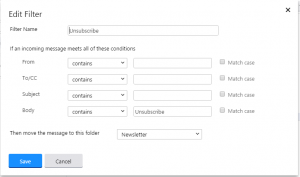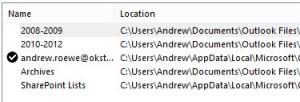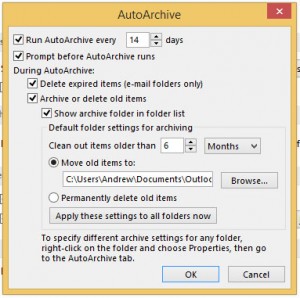Mailbox Management
Categories: End Users Howtos Information Instruction
I received an email the other day and sent a response. A few minutes after I had submitted my reply I received an auto-reply from the mail server saying:

A “full mailbox”: one of the banes of our existence. At OkState, when our mailboxes get full we can no longer send or receive emails, and this can make communication slightly painful. Nothing can get on your nerves faster than trying to send an important email only to have it bounce back as undeliverable. Most email services typically set a limit on the size of your email mailbox. Google gives you 15GBs to share across all their services and Yahoo has a limit of 1TB (1000GB). OkState provides a default mailbox size of 500MB. “But Andrew”, I hear you say, “500MB is not that much!” Well, on one hand, that is correct; however, with proper mailbox management you should find that 500MB is sufficiently large. Hopefully, in this post I will give you some ideas on how you can manage your mailbox.
So how do you tackle the mound of messages in your mailbox? The easiest way I have found is by using filters. Most online services and third-party programs allow the use of filters or rules to move incoming email into designated folders. A prime example of this function is with SPAM/JUNK folders. By default these services try to filter out email considered spam or junk. Through customization of these filters, you can easily set up folders for different types of emails. One filter that I find extremely useful is filtering the word “unsubscribe”:


As you can see from these two pictures, I created a filter that would scan the body of text in each incoming email for the word “unsubscribe”. If an email matches the criteria, the program will move the email into a folder called “Newsletters”. This has cleaned up my inbox extremely well. Once a week or so, I go through this folder to make sure there is nothing important in it and then delete the email messages.
Another way to lower the amount of messages in your inbox is to archive. Archiving your email is the process of removing old messages off the mail server and store them locally. Outlook is pretty decent when it comes to archiving. You can still access your archived emails from within Outlook. One of the downsides is that you will no longer be able to access those emails from the web interface, your phone, or your tablet. However, part of the reason we use archives is to move messages we no longer consider immediately necessary but need to keep for historical purposes. There are many ways to archive your emails, as you can see from the following picture I have grouped my archives by years. This allows me to easily find some emails based on when they were sent.

If you are worried about loosing your email messages, you can backup the archive files to your choice of location.
A great feature in Outlook for archiving is the ability to automate the process. When enabled, AutoArchive automatically archives your email messages. The default setting is to archive items about six months or older. Here you can see my default settings for AutoArchive.

In addition to the default settings, a really nice feature about AutoArchive is the ability to configure individual folders with their own settings. For example, you can have your items in your Sent folder archive anything older than one month instead of the default six.
While the default setting is perfectly fine for most all your email folders, I suggest adjusting the settings slightly different for your “Deleted Items” and “Sent Items” folders. Those two folders are typically the main hogs of your your space. In this picture you can see my AutoArchive settings for my “Inbox,” “Deleted Items,” and “Sent Items.”

My Inbox is set to the default settings, while my Deleted Items and Sent Items have custom settings. On top of that, my Deleted Items will actually delete the emails and not store them in my archive.
So here is where the real magic comes into play. You can have your filters and autoarchive work together to make mailbox management simple. Going back to my newsletter filter, on average I receive roughly five to ten “newsletters” a day into this folder. That is anywhere between thirty-five to seventy emails a week. One doesn’t really have the time to devote to weeding through all these emails. So I set the settings for the AutoArchive to delete anything older than one week and every two weeks, when AutoArchive runs, it reduces this folder to only a weeks worth of email.
So hopefully I have given you some basic tips on how to help manage your email mailbox. If you need help setting up your Archive or filters, check out the step-by-step guides over at Support.DASNR.Okstate.edu or contact your Technology Specialist.